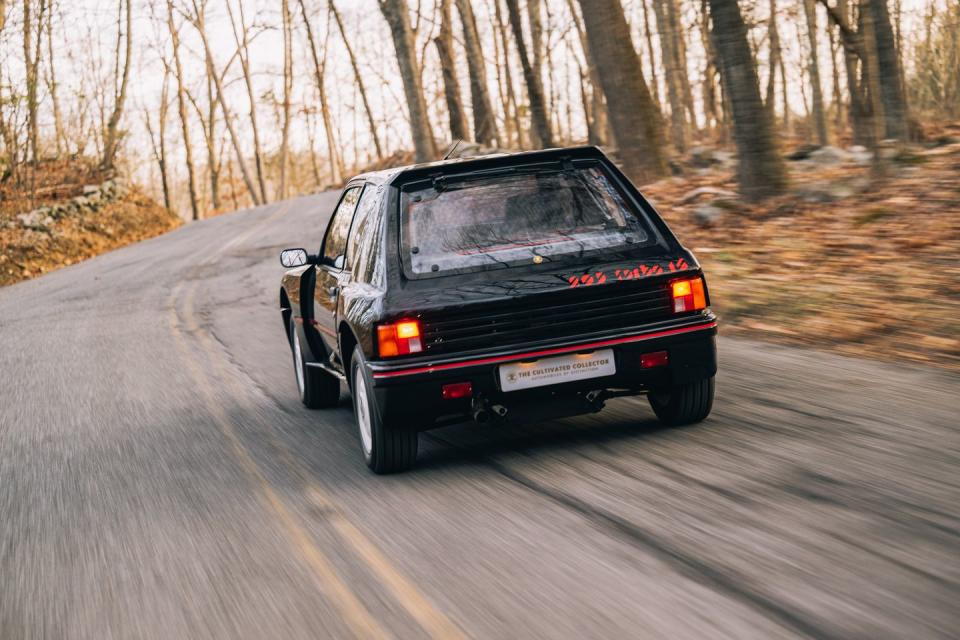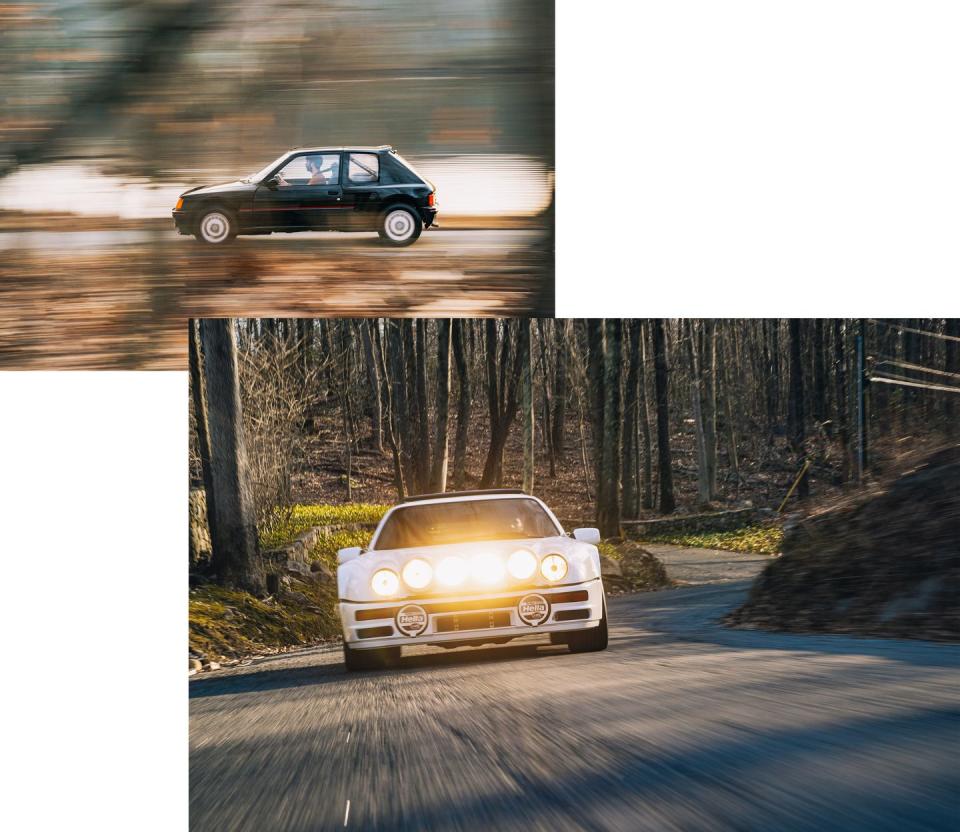Driving the Ford RS200 and Peugeot 205 T16: Group B Rally Legends


It doesn’t seem like anyone knew what they were setting in motion. After all, these were just rally cars, only faster. But something came unhinged under the Group B regulations, and the presence of these killer cars remains when you slide into the driver’s seat, when your nose burns from sweet fumes of race gas, and a narrow, bumpy, two-lane twists ahead.
On an unusually warm and sunny February afternoon, the Cultivated Collector gave us the keys to two impossibly rare Group B homologation specials: a 1986 Ford RS200 Evolution in race spec, one of 20 cars representing the final moment in Group B development, and a 1985 Peugeot 205 T16, one of 200 in the comfortable road spec. Since it was the most successful car of the Group B era, let’s start with the Peugeot.

It’s hard to grasp the Peugeot 205 T16’s story, even as one of the most successful and fearsome rally cars ever built, a cute French hatchback sawed in half then raised up like a lofted bed. Its workaday back seats were replaced by an engine boosted enough to touch the face of god.
Still, this 205 is an inexplicable chapter in Peugeot’s rally history; not that Americans know much about Peugots, a range of generally staid and sturdy cars, often station wagons with an extra set of shocks in the back for hauling. Peugeot’s rally cars had the same vibe. They were not blisteringly fast so much as punishingly tough. You do not imagine them sliding around Portugal’s fast tarmac stages; you imagine them dented and covered in mud, plowing through the Safari rally in east Africa.

There’s not a lot of postscript on the 205 T16 to latch onto, either. Peugeot brought this car out in late 1984, won nearly every rally it entered that season, won the 1985 championship, won the title again the next year, and then Group B disbanded. Only in the late-Nineties did Peugeot field a top-rung car in the WRC again. This 205 T16 was a flash, a lightning bolt with a steering wheel.
To get the 205 T16, knowing two names are useful. Heuliez is first. It was the little shop Peugeot contracted to construct the 205 T16. Heuliez built and worked on prototype race cars, including the Peugeot-powered WM P88 that crested 250 miles per hour down the Mulsanne Straight at Le Mans. No car had ever gone as fast, no car has bested its record ever since. The 205 T16 might be shaped like an upturned shopping cart, but it was assembled by a very serious team with access to the most advanced technology of its day.

The second name to remember is Jean Todt. He ran the 205 T16 program for Peugeot, hired on to oversee the whole operation. We know his name better for other triumphs, like beating Audi at Le Mans, and turning Ferrari around with Michael Schumacher. This project was a quick turnaround. Todt started with nothing in December 1981 and before August 1984 was over, Peugeot was beating the Audi Quattro.
The car 205 T16’s team proved resourceful. The car’s engine is based on the four-cylinder Peugeot XU block, the same one it used for its diesel commuters at the time. The mill has a twin-cam head, 16 valves, Bosch fuel injection, a KKK turbo, and an air-to-air intercooler. It’s road spec was rated to 200 hp, with early race-spec engines producing 340 horses. Later E2 evolution models were so powerful engineers detuned them to 500 hp.
That engine pairs to a somewhat baffling all-wheel drive system. With the engine mounted transversely, sitting just aft of the passenger’s seat, the transmission—also mounted transversely—sits adjacent to the engine, located just behind the driver. A coupling from the transmission sends power to a central viscous diff, shuttling power between the car’s front and rear axles. On each axle sits another limited-slip differential sending the power to the wheels. Amazingly, the difficult brief of finding such a transmission wasn’t difficult at all for the French engineers. The Citroën SM routed power the same way. The SM is a front-wheel-drive machine, with its engine longitudinally behind the front wheels with the transmission ahead of it. Peugeot owned Citroën then, and simply used SM transmissions for the 205 T16. The whole car is something like a Citroën SM mounted sideways in the back of the 205 T16. The T16’s drivetrain split torque 34-66 front to rear, per Car magazine, and while it had much better weight distribution compared to the Audi Quattro, it had a tendency to tilt midair over jumps – the engine mounted on the right side of the car gave it a bit of a lean.

To turn a 205 into a 205 T16, Heuliez did the same as Autodelta with the Lancia 037 and Delta S4: they chopped it in half and welded together an entirely custom subframe, lengthening the wheelbase and dividing the car with a firewall and a plate of glass. It turns the front half of the car into a little space pod. Even though the cabin terminates right behind your head, the view ahead of you is civilian. It’s easy to get in and out of, comfortable, fires up instantly and idles without drama. All that sets it apart is the huge driveshaft humps and the orange Jaeger gauges, and the fact that it sits sky high on its alloy four-bolt wheels. It looks like it’s on stilts.
The 205 T16 sort of drives like it, too. There’s almost nothing 205 in this car, but it does feel akin to the 205 GTi from Peugeot’s same lineup. It is a kind of floppy machine. No, that’s rude. It’s a car that glides and floats, breathing over the choppy road beneath it. It makes you want to drive it harder and harder.

And while something like the 205 GTi has a spritely naturally aspirated engine, the 205 T16 takes it to another level with its turbocharger. The engine’s power band suffers so much turbo lag that the 205 T16 will hardly get up even a small hill if you find yourself in the wrong gear. I tell you nothing happens in this car below 4000 RPM. From there? It shreds. This is a genuinely quick thing on boost. There’s something in the 205 T16. Some kind of spark.
It’s amazing – this is a largely bespoke, two-seater, mid-engine sports car. It cost as much as a Ferrari at the time, too, only it looked like a hatchback, could tackle any logging road you threw at it, and had a 24-gallon fuel tank.
We had the 205 T16 at the end of the day, the low winter sun set against the little ponds and bogs of this rocky corner of Connecticut. Last light glinted on the roof scoop, as absurd a feature as any hatchback has ever had. The white wheels glowed, the boxy headlights gleamed. For a c built only to satisfy racing requirements and sold only to recoup a fraction of the race team’s sprawling budget, this is a remarkably well put-together road car. The doors have a fine sound to them, the bolstered bucket seats are well trimmed. Heuliez turned out concept cars for Peugeot, also, and this has some of that whimsy.
Again, it is easy to drive, its thin steering wheel just like any other 205’s, emblazoned with ‘TURBO 16” as audaciously as one would hope for an Eighties product.
And just the same, driving it slowly reveals none of its frantic character. Off-boost, it’s a car. Light and tall and comfortable. The visibility is outstanding, hilarious only when you look over your shoulder to see another set of gaping intakes, one on each pillar behind the side glass.
The boost feels extraordinary. It’s only 200 hp, but they all arrive as a thud, a wave, a crescendo. It is only lightly comical that the gear lever is as pedestrian as it is in any 205, shaped like an old umbrella handle but linked to one of the most intricate and advanced pieces of Eighties racing tech.
This road that the Cultivated Collector has taken us to is a short stretch in between villages, empty but for boulders and trees, gritty and potholed. It is not a Corvette road. It is not a Ferrari road. Turns are off-camber and over crests. Only one turn is fast, coming down off a big compression. The Peugeot absorbs it all like a sponge. You’re not driving a car; you’re corralling a set of suspension components harnessed to a turbocharger. It leans and rolls and sets and disappears. Nothing about the car is intimidating behind the wheel, nothing obtuse or difficult to grab. I get why this thing dominated.

 Yahoo Autos
Yahoo Autos 